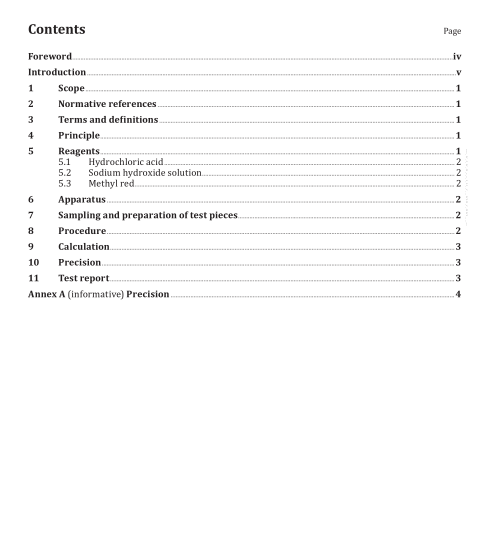ISO 10716:2022 pdf download.Paper and board — Determination of alkali reserve.
5.1 Hydrochloric acid
Standard reference solution, c(HCl) = 0,10 mol/l ± 0,001 mol/l.
5.2 Sodium hydroxide solution
Titrant, c(NaOH) = 0,1 mol/l.
5.3 Methyl red
Indicator solution for acidometric titration.
Dissolve 0,2 g of methyl red (2-[4-(dimethylamino)-phenylazo]lbenzoic acid) in 100 ml of ethanol.
6 Apparatus
The usual laboratory apparatus shall be used.
7 Sampling and preparation of test pieces
Ensure that the sample is representative of the lot to be tested. Where applicable, follow the instructions given in ISO 186.
Select from the sample enough test pieces to provide for the testing to be done, ensuring that these pieces are representative of the whole sample. Tear the pieces into smaller pieces, about 15 mm x 15 mm, and split thick board pieces. Wear protective gloves when handling the sample.
8 Procedure
Carry out this procedure in duplicate.
Weigh about 1 g of sample to the nearest 0,001 g. At the same time weigh a separate test portion for dry matter content determination in accordance with ISO 287 or ISO 638-1, as applicable.
Transfer the test portion to a clean 250 ml or 300 ml conical flask. Add about 100 ml of distilled water (or more if required to soak the test portion) and boil the mixture gently for 5 min. Allow the mixture to cool somewhat. With a pipette, add 20,0 ml of hydrochloric acid (5.1).
Bring the mixture to boiling again and allow it to cool for at least 15 min. Titrate with the sodium hydroxide solution (5.2) to the first lemon-yellow, using three drops of the methyl red solution (5.3) as the indicator.
If less than 5 ml of the sodium hydroxide solution are required to reach the end-point, repeat the procedure with a smaller test portion or with a larger volume of hydrochloric acid.
Carry out a blank determination by the same procedure but omit the sample.
NOTE The amount of acid, 20 ml or 2 mmol, is sufficient to neutralize an alkali reserve of up to 2 mol/kg [10 % (m/m) CaCO 3 ]. If the paper contains more than 1,5 mol/kg alkali reserve [7,5 % (m/m) CaCO 3 ], use a smaller test portion or a larger volume of hydrochloric acid.
If the sample is dyed so that the end-point cannot readily be detected, an electrometric (potentiometric) or automatic titrator may be used. However, glass electrodes are sensitive to the presence of suspended matter. If interference from suspended matter is observed, the suspension should be filtered before titration. If such a modification to the test procedure has been carried out, this shall be stated in the test report.
9 Calculation
Calculate the alkali reserve, X, expressed in moles per kilogram, from the expression:
X= V 0 -V 1 /V 0 x V 2 *c(HCl)/m
where
V 0 is the volume, in millilitres, of sodium hydroxide solution used in the blank titration;
V 1 is the volume, in millilitres, of sodium hydroxide solution used in the sample titration;
V 2 is the volume, in millilitres, of hydrochloric acid used (normally 20 ml);
c(HCl) is the concentration of the hydrochloric acid solution (5.1) in moles per litre;
m is the mass, in grams, of the oven-dry sample.
NOTE The expression above is obtained by combining the formula for the blank titration:
V 0 * c(NaOH) = V 2 *c(HCl)
with that for the sample titration
V 1 * c(NaOH) = V 2 * c(HCl) – Xm
and solving for X.
Duplicate determinations should agree within 0,07 mol/kg. If this is not the case, repeat the procedure with two more test portions.
Calculate the mean result and round it off to the first decimal place.
NOTE In this document, the alkali reserve represents moles per kilogram of an alkali in which the cation is monovalent. One mole of acid is equivalent to 0,5 mol of calcium carbonate, or 50 g of CaCO 3 . One per cent of calcium carbonate thus gives an alkali reserve of 0,2 mol/kg.
10 Precision
The results of an interlaboratory study to determine the precision of this method are presented in Annex A.
11 Test report
The test report shall include the following information:
a) a reference to this document, i.e. ISO 10716:2022;
b) date and place of test;
c) all information necessary for complete identification of the sample tested;
d) the mean alkali reserve, calculated according to Clause 9, expressed in moles per kilogram to the nearest 0,1 mol/kg;
e) any unusual features observed during the test;
f) any departure from the procedure described in this document, or any other circumstances that may have affected the test results.ISO 10716 pdf download.ISO 10716 pdf download
